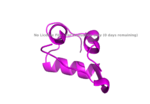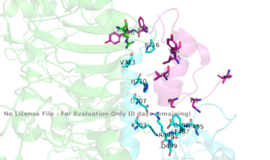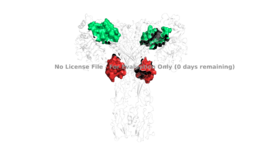Sandbox Reserved 1627
From Proteopedia
(Difference between revisions)
| Line 1: | Line 1: | ||
==''Homo sapiens'' Insulin Receptor== | ==''Homo sapiens'' Insulin Receptor== | ||
<StructureSection load='6sof' size='350' side='right' caption='An interactive view of the human insulin receptor. (PDB Codes [http://www.rcsb.org/pdb/explore/explore.do?structureId=6SOF 6SOF])' scene='83/832953/Active_insulin_receptor/11'> | <StructureSection load='6sof' size='350' side='right' caption='An interactive view of the human insulin receptor. (PDB Codes [http://www.rcsb.org/pdb/explore/explore.do?structureId=6SOF 6SOF])' scene='83/832953/Active_insulin_receptor/11'> | ||
| - | |||
| Line 24: | Line 23: | ||
== Function== | == Function== | ||
The insulin receptor's structure is critical to it's function. In regards to glucose homeostasis, the receptor begins the signaling pathway that will eventually move glucose transporters to the cell surface which will allow glucose to passively defuse into the cell. The glucose receptor is inactive in the absence of insulin. When a large meal is ingested and there is a surplus of glucose circulating in the blood stream, the production of insulin is upregulated and will bind to many insulin receptors. Upon activation, it undergoes a structural [http://en.wikipedia.org/wiki/Conformational_change conformation change] from the inactive <scene name='83/832953/Simple_inactivated_receptor/1'>inverted V</scene> state to the active <scene name='83/832953/Ir_dimer_t_state/1'>T shape</scene> state. Once activated, the Beta subunits are enabled to move close enough together to autophosphorylate and initate downstream signaling by the phosphorylation of the [http://en.wikipedia.org/wiki/Insulin_receptor_substrate Insulin Receptor Substrate] (IRS), ultimately resulting in glucose intake. | The insulin receptor's structure is critical to it's function. In regards to glucose homeostasis, the receptor begins the signaling pathway that will eventually move glucose transporters to the cell surface which will allow glucose to passively defuse into the cell. The glucose receptor is inactive in the absence of insulin. When a large meal is ingested and there is a surplus of glucose circulating in the blood stream, the production of insulin is upregulated and will bind to many insulin receptors. Upon activation, it undergoes a structural [http://en.wikipedia.org/wiki/Conformational_change conformation change] from the inactive <scene name='83/832953/Simple_inactivated_receptor/1'>inverted V</scene> state to the active <scene name='83/832953/Ir_dimer_t_state/1'>T shape</scene> state. Once activated, the Beta subunits are enabled to move close enough together to autophosphorylate and initate downstream signaling by the phosphorylation of the [http://en.wikipedia.org/wiki/Insulin_receptor_substrate Insulin Receptor Substrate] (IRS), ultimately resulting in glucose intake. | ||
| - | |||
===Conformation Change=== | ===Conformation Change=== | ||
The inactive form of the insulin receptor predominates in low-levels of circulating insulin, whereas the active conformation is seen when insulin binds to any of the 4 receptor sites. The inactive conformation resembles an inverted V, and the active conformation resembles a T shape. Images of the inverted V conformation shows only a protomer of the inactive alpha subunit because the entire inactive alpha subunit dimer has been unable to be photographed because the transition state has yet to be determined in full. In the V-shape, the FnIII-3 domains are separated by about 120A. At this distance, they cannot work together to autophosphorylate and initiate downstream signaling. Upon the binding of insulin to any of the four binding sites, the conformation change will begin and bring the FnIII-3 domains within 40A of each other, which is the T-state conformation. <ref> DOI 10.1038/s41467-018-06826-6</ref> <ref name="Uchikawa" /> The T shape conformation is well observed in the alpha subunit. It is horizontally composed of L1, CR (including the alpha-CT chain), and L2 domains and vertically composed of the FnIII-1, 2, and 3 domains. | The inactive form of the insulin receptor predominates in low-levels of circulating insulin, whereas the active conformation is seen when insulin binds to any of the 4 receptor sites. The inactive conformation resembles an inverted V, and the active conformation resembles a T shape. Images of the inverted V conformation shows only a protomer of the inactive alpha subunit because the entire inactive alpha subunit dimer has been unable to be photographed because the transition state has yet to be determined in full. In the V-shape, the FnIII-3 domains are separated by about 120A. At this distance, they cannot work together to autophosphorylate and initiate downstream signaling. Upon the binding of insulin to any of the four binding sites, the conformation change will begin and bring the FnIII-3 domains within 40A of each other, which is the T-state conformation. <ref> DOI 10.1038/s41467-018-06826-6</ref> <ref name="Uchikawa" /> The T shape conformation is well observed in the alpha subunit. It is horizontally composed of L1, CR (including the alpha-CT chain), and L2 domains and vertically composed of the FnIII-1, 2, and 3 domains. | ||
| - | |||
===Binding interactions=== | ===Binding interactions=== | ||
[[Image:Binding site with AA labeled.png|thumb|right|270px|Figure 3: Subunit interactions between the insulin receptor CT-alpha helix (light blue) and insulin (magenta) in one of the binding sites [http://www.rcsb.org/structure/6sof PDB 6SOF]]] | [[Image:Binding site with AA labeled.png|thumb|right|270px|Figure 3: Subunit interactions between the insulin receptor CT-alpha helix (light blue) and insulin (magenta) in one of the binding sites [http://www.rcsb.org/structure/6sof PDB 6SOF]]] | ||
The insulin receptor itself is held together by numerous critical disulfide bonds and [http://en.wikipedia.org/wiki/Salt_bridge_(protein_and_supramolecular) salt bridges]. These bonds maintain a stablized link between the dimers of the receptor, and without them, the conformation change from inactive to active would not be able to occur. One unique interaction within the receptor is known as a tripartite interaction. It occurs between the alpha-CT chain and the FnIII-1 domain region during a conformation chain, and involves the following residues:<scene name='83/832953/Alpha_ct_and_fniii-1/2'> ASP496, ARG498, and ASP99 on the FnIII domain</scene> and the <scene name='83/832953/Alpha_ct_and_fniii-1/3'>LYS703, GLU706, and ASP707 on the alpha-CT domain</scene> . This duo then interacts with the leucine rich region, L1, that exists on the opposing protomer of the dimer. | The insulin receptor itself is held together by numerous critical disulfide bonds and [http://en.wikipedia.org/wiki/Salt_bridge_(protein_and_supramolecular) salt bridges]. These bonds maintain a stablized link between the dimers of the receptor, and without them, the conformation change from inactive to active would not be able to occur. One unique interaction within the receptor is known as a tripartite interaction. It occurs between the alpha-CT chain and the FnIII-1 domain region during a conformation chain, and involves the following residues:<scene name='83/832953/Alpha_ct_and_fniii-1/2'> ASP496, ARG498, and ASP99 on the FnIII domain</scene> and the <scene name='83/832953/Alpha_ct_and_fniii-1/3'>LYS703, GLU706, and ASP707 on the alpha-CT domain</scene> . This duo then interacts with the leucine rich region, L1, that exists on the opposing protomer of the dimer. | ||
| - | [[Image:4 sites highlighted.png|thumb|right|260px|Figure 4: Sites 1 | + | [[Image:4 sites highlighted.png|thumb|right|260px|Figure 4: Sites 1 and 1' (green), 2, and 2'(red). [http://www.rcsb.org/structure/6sof PDB 6SOF]]] |
It is generally more common for only one or two insulin molecules to bind to the receptor due to the occurrence of negative affinity at the binding site, as well as the location of the second two binding sites on the back side of the receptor with Beta sheets and the lack of surface area they have. For this reason, studies support that optimal insulin receptor activation requires the binding of ligands to two insulin binding sites. Binding of at least one insulin is required for the activation of the insulin receptor and the change in conformation to the active T state. <ref> DOI 10.7554/eLife.48630 </ref>. | It is generally more common for only one or two insulin molecules to bind to the receptor due to the occurrence of negative affinity at the binding site, as well as the location of the second two binding sites on the back side of the receptor with Beta sheets and the lack of surface area they have. For this reason, studies support that optimal insulin receptor activation requires the binding of ligands to two insulin binding sites. Binding of at least one insulin is required for the activation of the insulin receptor and the change in conformation to the active T state. <ref> DOI 10.7554/eLife.48630 </ref>. | ||
| - | Ligand binding interactions are different at <scene name='83/832953/Sites_1_and_1_prime_location/2'>sites 1 and 1'</scene> and <scene name='83/832953/Sites_2_and_2_prime_location/2'>sites 2 and 2'</scene> | + | Ligand binding interactions are different at <scene name='83/832953/Sites_1_and_1_prime_location/2'>sites 1 and 1'</scene> and <scene name='83/832953/Sites_2_and_2_prime_location/2'>sites 2 and 2'</scene> (Figure 4). The interactions at all 4 binding sites are highly hydrophobic, but there are differences between the sites. Binding sites 1 and 1' have two cystines in a disulfide bond linkage along with HIS B5 all from insulin interacting with <scene name='83/832953/Sites_1_and_1_prime_location/3'>PRO495, PHE497, ARG498</scene> residues from the FnIII-1 domain. At sites 2 and 2' the interaction with insulin involves more residues than at the first two sites. The FnIII-1 region has <scene name='83/832953/Sites_2_and_2_prime_location/3'>both basic residues-ARG479, LYS484, ARG488, ARG554- and hydrophobic residues- LEU486, LEU552, and PRO537</scene>- interacting with insulin's resides and numerous locations along its surface. |
== Relevance == | == Relevance == | ||
Revision as of 02:19, 7 April 2020
Homo sapiens Insulin Receptor
| |||||||||||
References
- ↑ 1.0 1.1 Tatulian SA. Structural Dynamics of Insulin Receptor and Transmembrane Signaling. Biochemistry. 2015 Sep 15;54(36):5523-32. doi: 10.1021/acs.biochem.5b00805. Epub , 2015 Sep 3. PMID:26322622 doi:http://dx.doi.org/10.1021/acs.biochem.5b00805
- ↑ 2.0 2.1 2.2 Uchikawa E, Choi E, Shang G, Yu H, Bai XC. Activation mechanism of the insulin receptor revealed by cryo-EM structure of the fully liganded receptor-ligand complex. Elife. 2019 Aug 22;8. pii: 48630. doi: 10.7554/eLife.48630. PMID:31436533 doi:http://dx.doi.org/10.7554/eLife.48630
- ↑ Weis F, Menting JG, Margetts MB, Chan SJ, Xu Y, Tennagels N, Wohlfart P, Langer T, Muller CW, Dreyer MK, Lawrence MC. The signalling conformation of the insulin receptor ectodomain. Nat Commun. 2018 Oct 24;9(1):4420. doi: 10.1038/s41467-018-06826-6. PMID:30356040 doi:http://dx.doi.org/10.1038/s41467-018-06826-6
- ↑ Uchikawa E, Choi E, Shang G, Yu H, Bai XC. Activation mechanism of the insulin receptor revealed by cryo-EM structure of the fully liganded receptor-ligand complex. Elife. 2019 Aug 22;8. pii: 48630. doi: 10.7554/eLife.48630. PMID:31436533 doi:http://dx.doi.org/10.7554/eLife.48630
- ↑ Wilcox G. Insulin and insulin resistance. Clin Biochem Rev. 2005 May;26(2):19-39. PMID:16278749
- ↑ Riddle MC. Treatment of diabetes with insulin. From art to science. West J Med. 1983 Jun;138(6):838-46. PMID:6351440
Student Contributors
- Harrison Smith
- Alyssa Ritter




